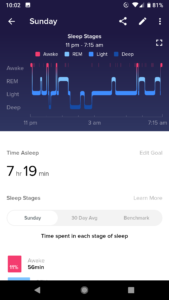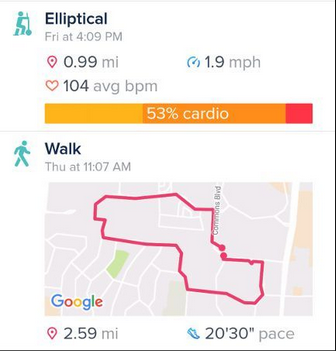This Christmas I got a Fitbit Charge 3 fitness tracker that tracks steps, heart rate and sleep quality. It has a grey-scale touchscreen that displays the date and time along with steps or heart rate when tapped. It can also display text messages, calls, and email from a phone.

I really like having a fitness tracker that also displays the date/time. I also appreciate having heart rate data for workouts and getting notifications on the watch.
Compared to Jawbone
I had a Jawbone fitness tracker from 3/2015 to 9/2016. I liked the tracker, but the band broke twice in the same spot, and once it was out of warranty I wasn’t willing to buy a new one.
The technology has improved quite a bit over the last couple years. In a device that is physically a little wider, the Fitbit is lighter, has a display, a longer battery life, and tracks heart rate all day.
Fitness Tracking
The Fitbit tracker is very dependent on its connection to the phone. All the data it collects is passed to the phone app, and the app is the primary display for health data. With the app, you can add naps/workouts that the tracker didn’t notice. You can also track food/water and weight.
Workouts
You can manually start a workout on the tracker or app. The app will also detect some workouts and record them automatically. It has a variety of workout types, but I haven’t noticed much difference between them. The interval workout will vibrate the tracker for start/stop of intervals and the walk/run/bike workouts will link up with the phone GPS to give you a track and split data.
Sleep
The Fitbit automatically detects both naps and overnight sleep. I find it a little too aggressive about when it thinks I’m sleeping. If I read before going to bed it almost always counts that as sleeping. It is pretty easy to edit a sleep, but I have to do it a lot.
It tracks wake/light/deep/rem sleep and will show you how you compare to the averages for your age group. While it is hard to know, it does seem accurate: If I wake up groggy I was in deep, if I wake up from a dream I was in REM.

Heart Rate
The Fitbit tracks heart rate all day. It also keeps track of your “resting heart rate”. It is interesting to see the heart rate over the day – I was a little surprised by how much heart rate goes up for very light activity. It was also interesting to see how long it takes for heart rate to recover after a workout and how stress effects heart rate.
It also reports a cardio fitness score which is an estimate of your VO2 Max (the amount of oxygen your body can use during exercise). It gave me a range based on my resting heart rate and then refined it to a single value after I went for a run. I have no way to know if it is accurate.
Steps
Between when the Jawbone broke and getting the Fitbit, I’d been using the Google Fit phone app to track steps. I used both trackers for a couple weeks and found that the Fitbit was reporting 40% more steps than Google Fit. Some of that is certainly due to times when I’m not carrying the phone, but I have my phone on me most of the time and I was surprised by how much difference there was. I don’t know which is more accurate. I did one walk where I counted the steps manually, and both Google Fit and Fitbit were very close to my count.

Weight/Food/Water
The Fitbit app will also let you track your weight, food and water. I use the weight tracking. It is pretty quick to add an entry and it graphs your weight and provides a trend line. I’m not using the food/water tracking. It works fine if you are eating fast-food or pre-packaged foods, but as soon as you go to a restaurant without calorie information or eat at a friend’s house, tracking becomes impossible.
Smartwatch Features
When you raise your arm or double tap the tracker, the screen turns on to display the time and date (you can pick from 15 or so watch faces). It also shows steps and/or heart rate.
When you get a notification on your phone from supported apps (calendar, messaging, phone, email, etc.) the tracker vibrates and displays the message. It even has a couple very simple actions you can take for each notification type. I’ve found this to be a very useful feature, saving me from getting out my phone several times a day.
Other
Fitbit doesn’t have as good of a data privacy policy as Jawbone did. But at least you can download your data using their API. I added code to the Timeline program to download the Fitbit data, so I can use that application to view and backup my data. It is easy to rely on corporations and “the cloud” to save your data, but Jawbone has gone out of business and you can no longer download your data from them.
The Fitbit has a few non-fitness features. There is a countdown timer and silent alarms. You can also have a “reminder to move”, but it went off while I was trying to nap so I disabled it. They also have a “relax” mode that is basically guided breathing.
There is a social and motivational component to the app. You can compare yourself to your friends who have a Fitbit and participate in challenges with them.
Fitbit “Coach” is an optional personalized training app that costs $40/year and has audio/video coaching. I haven’t tried it out.



